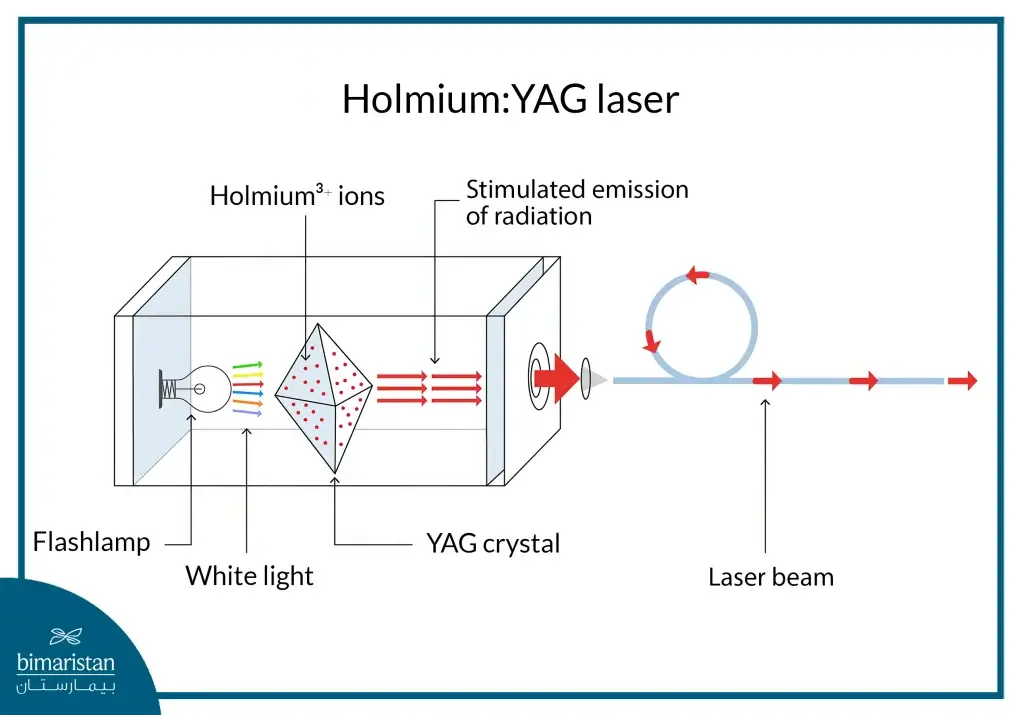Urinary stones laser surgery is one of the most advanced and accurate methods for treating kidney, ureter, and bladder stones, especially when drug therapy or external shock wave lithotripsy fails. This technique uses lasers to fragment stones directly under endoscopic vision, minimizing the risk of damage to surrounding tissues.
Thanks to its excellent results and low complication rates, urinary stones laser surgery has become a preferred option for many patients in both simple and complex cases, particularly with the availability of various modern lasers that allow effective and precise fragmentation based on the stone’s size and location.
What are urinary tract stones?
Urinary tract stones are solid masses that form inside the urinary system as a result of the accumulation and deposition of minerals and salts dissolved in the urine, these masses may be located in any part of the urinary tract, as they may form in the kidneys, ureters, bladder, or urethra, and the destruction is according to the location, such as breaking up kidney stones, and these stones vary in size and chemical composition and their effect depends on their location and the extent to which they block the urinary tract.
Common causes of urinary stones
The main causes of urinary stone formation are:
- Chronic dehydration
- Reduced urine volume
- A diet high in protein, sodium or oxalate
- Metabolic disorders (such as hyperparathyroidism)
- Some medicines
- Family history of gallstones
Common symptoms of urinary stones
Symptoms vary depending on the location and size of the stone, with the most common being:
- Sudden, severe pain in the flank or lower abdomen (renal colic)
- Frequent or difficult urination
- Blood in the urine in some cases
- Burning sensation during urination
- Nausea or vomiting in some cases
- Frequent urinary infections
If the stone is small, it may dissolve on its own with sufficient fluid intake, but for larger stones or those that cause obstruction or persistent pain, medical intervention may be required. Laser therapy is one of the modern and less invasive options, as it is used to break up stones accurately without the need for traditional surgery.
When is urinary stones laser surgery recommended?
Urinary stones laser surgery is recommended when drug therapies or shock wave lithotripsy (ESWL ) fail to completely break up the stone or if the stone is large in size, hard in structure, or located in hard-to-reach areas such as the distal ureter or urethra, or if symptoms recur despite conservative treatments, or if the presence of the stone causes obstruction of urine flow that may lead to kidney damage, or if there is a chronic urinary infection or persistent high fever. It is a safe option for patients with persistent pain that cannot be controlled with painkillers or who are at risk of complications if treatment is delayed.
Urinary stones laser surgery steps
Urinary stones laser surgery is one of the latest methods used to break up stones inside the kidney, ureter, or bladder accurately and effectively:
- Preoperative evaluation: A thorough clinical examination, blood and urine tests, and radiographs such as CT scans or ultrasound scans are ordered to determine the size and location of the stone, then the choice of anesthesia (general or spinal) is discussed depending on the location of the stone and the patient’s health condition.
- Patient preparation and anesthesia: No food is allowed several hours before surgery, and the patient is placed under appropriate anesthesia to ensure complete comfort.
- Insertion of a ureteroscope: A thin scope is inserted through the urethra (Rigid or Flexible Ureteroscope) and the scope is advanced towards the stone, whether in the bladder, ureter, or kidney.
- Seeing the stone directly: The stone is accurately identified via camera, where its size, hardness, and location are determined to determine the method of fragmentation.
- Laser lithotripsy: To turn these stones into small fragments that are easily removed, one of the following lasers is used:
- – Holmium: YAG Laser (most common)
- – Thulium Fiber Laser (TFL) (newer and more accurate)
- There are other less common types, such as Pulsed Dye Laser and Neodymium : YAG (Nd:YAG) lasers, but they are rarely used in modern practice to treat urinary stones, due to their limited effectiveness compared to newer technologies.
- Remove the fragments or allow them to pass spontaneously: Remove the fragments with forceps or let them be excreted with urine if they are small enough.
- Temporary urinary stent placement (if needed): A Double-J stent is placed inside the ureter to facilitate urination and minimize swelling after surgery.
- Monitoring after surgery: The patient is monitored for a few hours and then discharged, often on the same day.

Advantages of urinary stones laser surgery
Laser surgery is one of the most effective and safe options for treating urinary tract stones, especially when drug treatments or shock wave lithotripsy (ESWL) have failed:
- Highly effective in breaking up all types of stones, including hard and complex stones that are resistant to other treatments
- A minimally invasive, laparoscopic procedure without the need for incisions, which minimizes pain and the risk of infection
- Precision and direct targeting, as the doctor can break up stones without damaging the surrounding tissue
- Patients often return to their daily lives within a few days without the need for a long hospital stay
- A high success rate of over 90% in the most recent clinical studies.
Possible complications of laser surgery
Although relatively safe, some minor side effects may occur:
- Urinary tract infection: Often temporary and treated with antibiotics.
- Mild bleeding or blood in the urine (hematuria): Goes away on its own within days.
- Irritation in the bladder or urethra: May lead to frequent urination or a burning sensation.
- Rare debris blockage: The result of small fragments of stones remaining.
- Very rare complications: Injury to the ureter or bladder during the procedure, usually treated conservatively or with temporary catheterization.
Comparison of laser surgery with other treatments
Urinary stones laser surgery is an advanced option that is more effective and more comfortable than traditional methods, and the following table shows the main differences between it and other options:
| Criterion | Laser surgery | Impact Wave Fragmentation | Open surgery |
|---|---|---|---|
| Type of procedure | Minimally invasive laparoscopic | non-invasive | My incision is through a surgical incision |
| Effectiveness of complex lithotripsy | Very high | Medium | High |
| Percentage of complete elimination of stones | Often in one sitting | In several sessions | Often in one sitting |
| Complication rate | low | Low to medium | Medium to high |
| The need for repetition | Rarely repeated | Possible, depending on the situation | Rarely repeated |
Follow-up after urinary stones laser surgery
The post-operative phase is the most important part of treatment and prevention of recurrence or complications, which includes the post-procedure medical protocol:
- Immediate post-operative monitoring: The patient remains under observation for several hours to monitor vital signs and ensure normal urination, especially when a temporary catheter is inserted.
- Drink plenty of fluids: Increase your water intake to help flush out small stones and prevent new stones from forming.
- Pain control: A mild analgesic may be prescribed as needed as the discomfort subsides within a few days.
- Prophylactic antibiotics: Sometimes prescribed to prevent infection, especially if a urinary catheter is present.
- Temporary cessation of strenuous activities: The patient is asked to avoid lifting weights or vigorous exercise for 7-10 days.
- Follow-up urinalysis and imaging: A periodic review is conducted after two to four weeks to assess the effectiveness of the surgery and to ensure that the urinary tract is free of any stone debris.
- Dietary guidance depending on the type of stone: After analyzing the removed stone, appropriate dietary guidelines are determined to minimize the likelihood of recurrence.
Why is Turkey an excellent choice for urinary stones laser surgery?
Turkey is one of the world’s leading medical destinations for urinary stones laser surgery, combining advanced laparoscopic and laser technologies with top-tier medical expertise. It has become a preferred choice for patients from Europe and the Middle East thanks to its ideal balance between quality and cost.
- Extensive experience in urinary stones laser surgery: Performed by specialized doctors trained in international centers, skilled in using various laser types.
- State-of-the-art equipment: Including Holmium: YAG and Thulium lasers, alongside advanced flexible endoscopes used in major medical centers.
- Favorable costs: The cost of urinary stones laser surgery in Turkey ranges from 1,500–3,000 USD—about 60–70% less than in Europe or America while maintaining the same medical standards.
- Speed of care: Procedures are often scheduled within 2–5 days of arrival, avoiding long waiting periods.
- Comprehensive pre- and post-operative care: Covering accommodation, check-ups, follow-ups, and medical translation, ensuring international patients receive treatment safely and comfortably.
Urinary stones laser surgery is one of the most successful modern options for eliminating urinary stones, especially when medication or external fragmentation fails. This technique offers high precision and excellent results while reducing pain and accelerating recovery. Thanks to advancements in the field, even complex stones can now be treated safely and effectively. Selecting the right medical center and benefiting from the expertise of an experienced team are essential to achieving the best outcomes.
Sources:
- National Institute of Diabetes and Digestive and Kidney Diseases. (n.d.). Kidney stones. National
- MedlinePlus. (n.d.). Kidney stones. U.S. National Library of Medicine.
